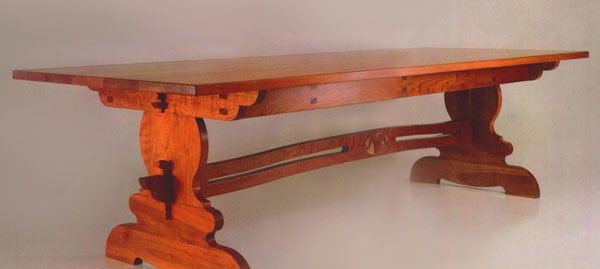
Synopsis: James Merritt Dunlap, who lives in Alaska, made a knockdown trestle table that has self-tightening, shallow-tapered, loose-wedged tenons, good for enduring extreme humidity changes. Just slightly jarring the table brings the tenons further into the mortises and tightens the joints. Dunlap conditions the wood to predict movement, and glues up the tabletop. He explains how to make the apron assembly and join the trestle post and base. He uses a three-tenon slide-bolt connection and shows where it fits on the table, and then explains his self-tightening draw wedges. Exploded drawings clarify how this table fits together.
A trestle table is one of the earliest examples of knockdown furniture. But like other easy-to-move knockdowns, it tends to become loose and wobbly the longer it’s used and the more its wood moves due to seasonal humidity changes. So, when a client asked me to build a large, solid-black-cherry dining table that he could disassemble and take to his Alaskan cabin, I decided to improve the traditional trestle design by adding self-tightening joints. I figured these joints would be especially important in Alaska, where even permanently fixed joints loosen because of wood movement caused by extremes in humidity. The indoor relative humidity can be near 0% during our dry, subzero winter and jump to almost 100% during summer’s arctic rainy season, which is similar to the monsoon season in the tropics. In these conditions, a blackcherry board that’s 12 in. wide in winter predictably swells up to in. in summer and then shrinks back the following winter. To avoid problems created by such drastic wood movement, I built the table shown above with self-tightening, shallow-tapered, loosewedged tenons, which the Dutch developed in the 1600s. When the long tenons securing the stretcher to the trestles become loose, slightly jarring the table causes the slick shallow-pitched wedges to fall farther into their mortises and tighten the joints.
As you can see in figure 1 on p. 40, the trestle posts are pinned to the apron assembly with wood slide bolts. The slide bolts’ long center tenons extend through mortises in the posts and aprons, and are wedged to draw the pieces together. Each slide bolt also has two shorter blind tenons that extend through the post and partway into the apron. These tenons hold the apron down on the trestle post and keep the top from rocking. Although not visible in the photo above, the trestles themselves also rely on wedges to hold their two parts (post and base) together. The post, or vertical portion of the trestle, has a large tenon that goes all the way through a mortise in the trestle base, as shown in figure 1. But since the grain of the post runs vertically and that of the base runs horizontally, these parts could not be glued together. So to secure the post to the base, I angled the ends of the mortise so it was wider at the bottom and inserted a wedge on both sides of the tenon. These wedges effectively turn the tenon into a large dovetail, and they can be driven in deeper if the post tenon shrinks in dry weather.
From Fine Woodworking #89
For the full article, download the PDF below:
Fine Woodworking Recommended Products


Blackwing Pencils

Dividers





















Log in or create an account to post a comment.
Sign up Log in